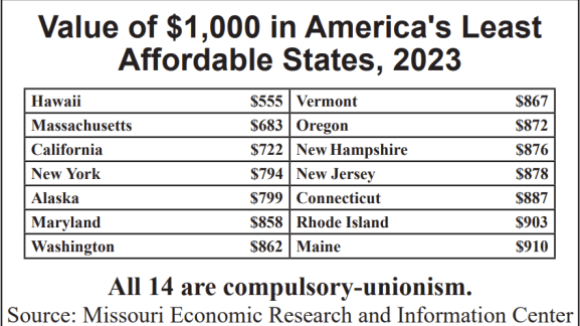Banning Compulsory Dues Curbs Cost of Living
On average, forced-unionism states are 23.2% more expensive to live in than Right to Work states. And decades of academic research show that compulsory unionism actually fosters a higher cost of living.
Yesterday the U.S. Commerce Department’s Bureau of Economic Analysis (BEA) issued its initial estimates for total 2014 private-sector, nonfarm employment in the 50 states. The BEA simultaneously released revised estimates for overall state personal income and an array of specific kinds of income, including employee compensation in the form of wages, salaries, benefits and bonuses.
The 2014 BEA employment and income data show once again that there is a strong negative correlation between compulsory unionism and economic growth.
Nationwide, private-sector nonfarm employment as reported by the BEA grew by 11.6% from 2004 to 2014. (Unlike the establishment jobs data tracked by the U.S. Labor Department’s Bureau of Labor Statistics, BEA data encompass self-employment and contractual employment as well as payroll jobs.) However, some states fared far better than others.
States that protect employees from being fired for refusal to pay dues or fees to an unwanted union enjoyed substantially more job growth than states where compulsory unionism is still permitted. Twenty-two states had bans on compulsory unionism, commonly known as Right to Work laws, on the books throughout the last decade. Three states, Indiana, Michigan and Wisconsin, have passed Right to Work laws since early 2012. And 25 states remain forced-unionism today.
All of the five top-ranking states for 2004-2014 private-sector employment growth are Right to Work states. Meanwhile, all of the eight lowest-ranking states for private-sector job growth lacked Right to Work laws as of 2014. (Since Indiana and Michigan prohibited compulsory unionism only a few years ago, they are excluded from this analysis. Since Wisconsin’s Right to Work law was not adopted until this year, it is counted as a forced-unionism state here.)
Overall, BEA-reported private-sector, nonfarm employment in Right to Work states grew by 15.9% over the past decade. That increase is 66% greater than the average for forced-dues states, and 37% greater than the national average. (See the link below for more details.)
And workers in forced-unionism states suffer from lower compensation growth as well as fewer job opportunities.
From 2004 to 2014, inflation-adjusted private-sector compensation increased by 15.5% in Right to Work states. That’s more than 1.5 times as much as the national average and more than 1.8 times as much as the forced-unionism state average. (See the second link below for more information. The BEA data are adjusted for inflation using the Labor Department’s Consumer Price Index.) Eight of the nine bottom-ranking states for compensation growth lacked Right to Work laws as of 2014.

Total Full-Time and Part-Time Employment by Industry (SA25, SA25N)
Compensation of Employees by Industry (SA6, SA6N)

On average, forced-unionism states are 23.2% more expensive to live in than Right to Work states. And decades of academic research show that compulsory unionism actually fosters a higher cost of living.

Jewish MIT students assert their rights under Civil Rights Act by requesting religious exemptions from funding union, but union officials continue to demand dues payments

Two worker witnesses testify in support of National Right to Work Act; Right to Work enjoys vast majority support among Americans…